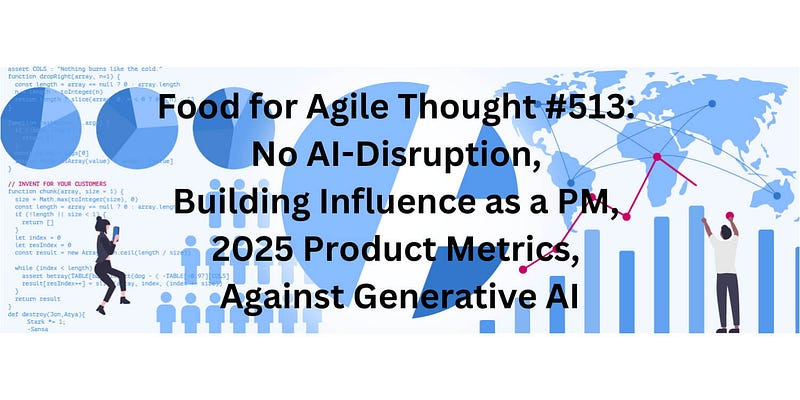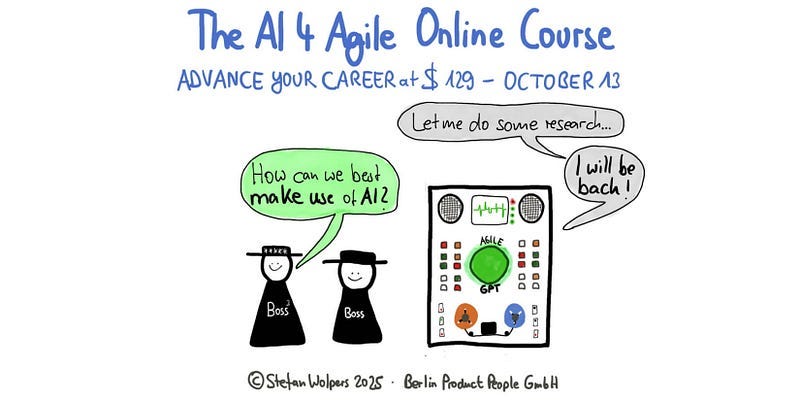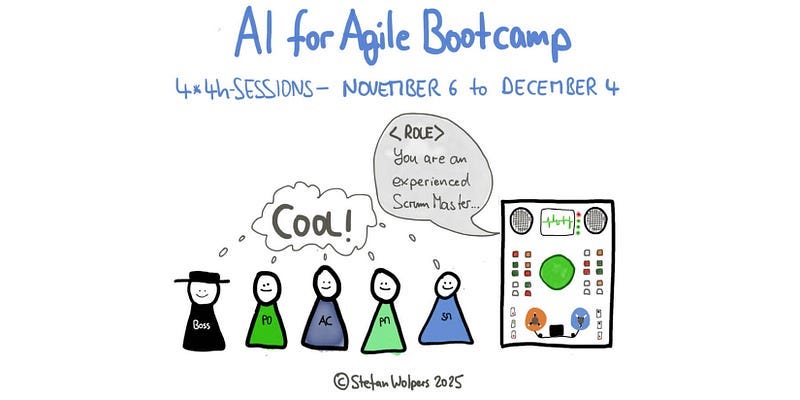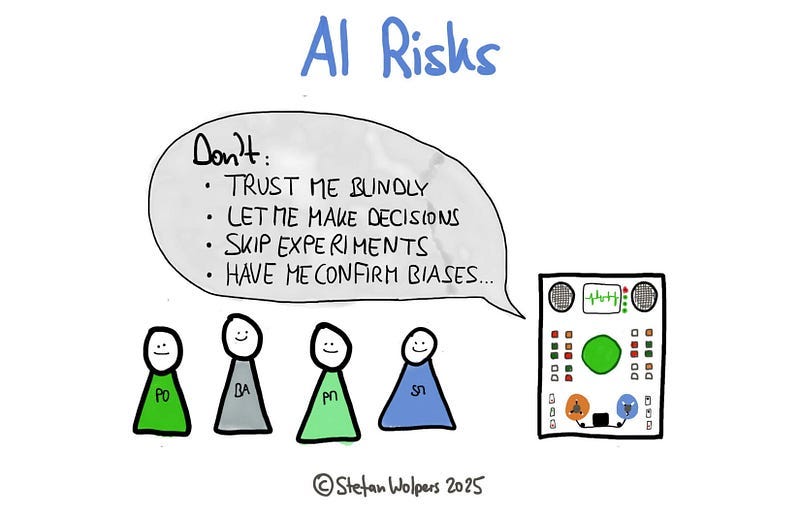Food for Agile Thought #513: No AI-Disruption, Building Influence as a PM, 2025 Product Metrics, Against Generative AI
Also: Origins of Complex Systems, Endless Discovery, AI Maturity Models?
Hello everyone!
Welcome to the 513th edition of the Food for Agile Thought newsletter, shared with 40,441 peers.
This week, Martha Gimbel, Molly Kinder, Joshua Kendall, and Maddie Lee report that there have been no economy-wide AI-disruption of the labor market since 2022 and call for better usage data. Maarten Dalmijn warns AI sped shipping bloats products and urges subtraction-minded PMs. Brian Balfour and Lauryn Motamedi rethink SaaS pricing by leveraging system-level levers and providing customer education. Also, Ethan Mollick shows near-expert AI agents shifting tasks under expert oversight, and Naval Ravikant advocates for iterative simplification and clear ownership.
Next, Chad McAllister interviews Rich Mironov on product leadership that speaks revenue, merchandises wins, cuts waste, and mentors for pragmatic team design. At the same time, Jana Paulech cautions against endless discovery and advocates simple, hypothesis-led research tied to business goals. Edward Zitron argues the generative AI boom is a fragile, Nvidia-dependent bubble. Leah Tharin spotlights 2025 benchmarks where activation speed drives retention, and OpenAI unveils GDPval, expert-graded tasks showing frontier models nearing expert quality.
Lastly, Jing Hu reports research showing that AIs favor AI-written content by 60 to 95 percent, urging audits of AI gatekeepers and strategic polishing without compromising human judgment. Seth Godin frames AI as infrastructure, shifting value to ambition, taste, and community. John Cutler, on the other hand, warns against comforting narratives, urging leaders to co-author cause-and-effect stories and surface risks early. Finally, Barry O’Reilly rejects maturity models, favoring outcome metrics, experiments, coaching, and DORA-like measures.
🎓 🇬🇧 🤖 The AI 4 Agile Online Course at $129 — October 13, 2025
I developed the self-paced AI 4 Agile Online Course for agile practitioners, including Product Owners, Product Managers, Scrum Masters, Agile Coaches, and delivery professionals who want to integrate artificial intelligence into their workflows with clarity, ethics, and purpose.
You don’t need to become an AI expert. However, you do need to understand how LLMs like ChatGPT, Claude, or Gemini can support real agile work and where their limitations lie. Like Jim Highsmith said, AI isn’t just a tool, but a new context for agility.
This course shows you how to do precisely that.
What’s Included:
10+ hours of self-paced video modules
A cohort-hardened, proven course design
Learn to 10x your effectiveness with AI; your stakeholders will be grateful
Delve into classic agile use cases of AI
Help your team create more customer value
All texts, slides, prompts, graphics; you name it
Access custom GPTs, including the “Scrum Anti-Patterns Guide GTP”
Enjoy community access for peer learning
Guaranteed: Lifetime access to all course updates and materials; there is a lot more to come
Certificate of completion.
👉 Please note: The course will only be available for sign-up at $129 until October 20, 2025! 👈
🎓 Join the Waitlist of the AI 4 Agile Online Course Now: Master AI Integration for Agile Practitioners — No AI Expertise Required!
Did you miss the previous Food for Agile Thought issue 512?
🎓 Join Stefan in one of his upcoming Professional Scrum training classes!
🏆 The Tip of the Week: AI-Disruption
(via The Budget Lab at Yale): Evaluating the Impact of AI on the Labor Market: No ‘Discernible Disruption’
Overall, our metrics indicate that the broader labor market has not experienced a discernible disruption since ChatGPT’s release 33 months ago, undercutting fears that AI automation is currently eroding the demand for cognitive labor across the economy.
Martha Gimbel, Molly Kinder, Joshua Kendall, and Maddie Lee find that there has been no economy-wide AI job disruption since 2022, with occupational shifts being modest, exposure unrelated to employment changes, and comprehensive usage data being needed to assess future impacts.
Source: The Budget Lab at Yale: Evaluating the Impact of AI on the Labor Market: No ‘Discernible Disruption’
🎯 Product
🎙 Chad McAllister and Rich Mironov: Building Influence as a Product Leader
Chad McAllister interviews Rich Mironov on product leadership: speak revenue, merchandise wins to build trust, reduce product waste, delegate and mentor, and structure teams pragmatically to earn influence and smarter decisions.
Source: 🎙 Building Influence as a Product Leader
Authors: Chad McAllister and Rich Mironov
Maarten Dalmijn: AI: The Ultimate Product Killer
Maarten Dalmijn warns that AI-fueled shipping speed breeds bloated products; adding more features raises costs and complexity. He urges hiring PMs skilled at editing and removing, preventing Swiss Army Knife and Frankenstein outcomes through disciplined subtraction.
Source: AI: The Ultimate Product Killer
Author: Maarten Dalmijn
Brian Balfour and Lauryn Motamedi (via Reforge): How to Price Your AI Product or Feature
Brian Balfour and Lauryn Motamedi explain how AI upends SaaS pricing and urge a system view of monetization across scale, what, amount, and when, highlighting variable costs, pricing floors and ceilings, hybrid models, credit-based trials, and the need to educate customers.
Source: Reforge: How to Price Your AI Product or Feature
Authors: Brian Balfour and Lauryn Motamedi
(via Brainmates): Endless Discovery in Product Management: Why Discovery Needs a Plan
Jana Paulech warns against endless discovery, distinguishing it from continuous discovery, and urges simple research plans tied to business objectives, hypotheses, participants, and methods to prevent low-value work, accelerate insight, and rebuild stakeholder confidence.
Source: Brainmates: Endless Discovery in Product Management: Why Discovery Needs a Plan
🧠 Artificial Intelligence
Ed Zitron: The Case Against Generative AI
Edward Zitron contends that generative AI is a bubble: Nvidia-dependent, debt-fueled compute, circular deals, weak revenues, unprofitable products, unreliable models, and unrealistic capital needs, with OpenAI at the center, hyperscalers complicit, and customers scarce.
Source: The Case Against Generative AI
Author: Ed Zitron
Ethan Mollick: Real AI Agents and Real Work: The Race Between Human-centered Work and Infinite PowerPoints
Ethan Mollick argues that AI agents now perform economically valuable tasks, often to a near-expert quality, thereby shifting jobs by task. He demonstrates rapid gains in replication and agentic work, cautions against unnecessary output, and recommends expert-in-the-loop workflows for speed and control.
Source: Real AI Agents and Real Work: The Race Between Human-centered Work and Infinite PowerPoints
Author: Ethan Mollick
Jing Hu: AI Doesn’t Discriminate Against You. It Just Prefers Its Own Kind.
Jing Hu reports research showing AIs prefer AI-written content 60 to 95 percent, risking homogenized decisions. She advises auditing AI gatekeepers, sampling rejections, and strategically AI-polishing outputs while preserving human judgment.
Source: AI Doesn’t Discriminate Against You. It Just Prefers Its Own Kind.
Author: Jing Hu
📺 Seth Godin: The ‘Talking Dog’ Theory of AI
Seth Godin argues AI is an inevitable infrastructure, shifting value to ambition, taste, and community. Use AI for pushback and experimentation, while maintaining human judgment, counteracting status fears, and correcting tool biases, all while maintaining your standards.
Source: 📺 The ‘Talking Dog’ Theory of AI
Author: Seth Godin
🖥 💯 🇬🇧 AI for Agile BootCamp #4 — November 6 — December 4, 2025
The job market’s shifting. Agile roles are under pressure. AI tools are everywhere. But here’s the truth: the Agile pros who learn how to work with AI, not against it, will be the ones leading the next wave of high-impact teams.
So, become the one who professional recruiters call first for “AI‑powered Agile.” Be among the first to master practical AI applications for Scrum Masters, Agile Coaches, Product Owners, Product Managers, and Project Managers.
Tickets also include lifetime access to the corresponding online course, once it is published. The class is in English. 🇬🇧
Learn more: 🖥 💯 🇬🇧 AI for Agile BootCamp #4 — November 6 — December 4, 2025.
Customer Voice: “The AI for Agilists course is an absolute essential for anyone working in the field! If you want to keep up with the organizations and teams you support, this course will equip you with not only knowledge of how to leverage AI for your work as an Agilist but will also give you endless tips & tricks to get better results and outcomes. I thoroughly enjoyed the course content, structure, and activities. Working in teams to apply what we learned was the best part, as it led to great insights for how I could apply what I was learning. After the first day on the course, I already walked away with many things I could apply at work. I highly recommend this course to anyone looking to better understand AI in general, but more specifically, how to leverage AI for Agility.” (Lauren Tuffs, Change Leader | Business Agility.)
➿ Agile & Leadership
Naval Ravikant: Complex Systems Emerge From Iterations On Simple Designs
Naval Ravikant argues complex systems emerge from iterative simplification, urging leaders to question requirements, remove parts before optimizing, maintain a single accountable owner, and cultivate polymathic, hands-on learning to make smarter trade-offs across products and organizations.
Source: Complex Systems Emerge From Iterations On Simple Designs
Author: Naval Ravikant
John Cutler: ‘But We Have To Try Something!’
John Cutler warns against comforting narratives and safe fixes, urging leaders to co-author stories that link actions to effects, shift attractor states, surface risks early, and build predictability habits.
Source: ‘But We Have To Try Something!’
Author: John Cutler
Barry O’Reilly: Why AI Maturity Models Don’t Work
Barry O’Reilly argues that AI maturity models are misleading, advocating for outcome metrics and adaptive learning. Leaders should favor experiments, coaching, and DORA-like measures, improved decision processes, scaled workflows, and building mastery over staged roadmaps.
Source: Why AI Maturity Models Don’t Work
Author: Barry O’Reilly
📯 AI Risks: Why Product Professionals Are Sleepwalking Into Strategic Irrelevance
AI is tremendously helpful in the hands of a skilled operator. It can accelerate research, generate insights, and support better decision-making. But here’s what the AI evangelists won’t tell you: it can be equally damaging when fundamental AI risks are ignored.
The main risk is a gradual transfer of product strategy from business leaders to technical systems — often without anyone deciding this should happen. Teams add “AI” and often report more output, not more learning. That pattern is consistent with long-standing human-factors findings: under time pressure, people over-trust automated cues and under-practice independent verification, which proves especially dangerous when the automation is probabilistic rather than deterministic (Parasuraman & Riley, 1997; see all sources listed below). That’s not a model failure first; it’s a system and decision-making failure that AI accelerates.
The article is an extension to the lessons on “AI Risks” of the Agile 4 Agile Online course; see above. The research of sources was supported by Gemini 2.5 Pro.
🎓 Learn more: AI Risks: Why Product Professionals Are Sleepwalking Into Strategic Irrelevance.
🛠 Concepts, Practices, Tools & Measuring
Leah Tharin: How do good product metrics look like in 2025?
Leah Tharin highlights 2025 benchmarks showing activation speed drives retention, not acquisition. Top performers align sales and PLG to deliver first value fast, measure marketing by activation moments, and close the enterprise sevenfold retention gap.
Source: How do good product metrics look like in 2025?
Author: Leah Tharin
(via OpenAi): Measuring the performance of our models on real-world tasks
The authors introduce GDPval, a benchmark comprising 1,320 realistic tasks across 44 knowledge-work occupations, graded by experts. This benchmark shows that frontier models are nearing expert quality, while being faster and cheaper, while also acknowledging one-shot limits and plans for interactive evaluations.
Source: OpenAi: Measuring the performance of our models on real-world tasks
📅 Training Classes, Meetups & Events 2025
Upcoming classes and events:
🖥 💯 🇩🇪 October 21–22 — Live Virtual Class: Professional Scrum Product Owner Training (PSPO I; German)
🖥 💯 🇬🇧 November 6-December 4 — Live Virtual Cohort: AI for Agile BootCamp Cohort (English)
🖥 💯 🇬🇧 November 10–11 — Live Virtual Class: Professional Scrum Master — Advanced Training (PSM II; English)
🖥 🇩🇪 December 9–10 — Live Virtual Class: Professional Scrum Product Owner Training (PSPO I; German)
🖥 🇬🇧 December 16–17 — Live Virtual Class: Professional Scrum Master — Advanced Training (PSM II; English)
🖥 🇬🇧 December 18 — Live Virtual Class: Professional Scrum Facilitation Skills Training (PSFS; English)
👉 See all upcoming classes here
🗞️ Last Week’s Food for Agile Thought Edition
📺 Join 6,000-plus Agile Peers on YouTube
Now available on the Age-of-Product YouTube channel:
Hands-on Agile #68: How to Analyze Unstructured Team Interview Data with AI.
Hands-on Agile 2025: The 5 Obstacles to Empowered Teams — Maarten Dalmijn
Hands-on Agile 2025: The Top Reasons Why a Product Strategy Fails — Roman Pichler
Hands-on Agile 2025: Taylorism-Lean-Agile-Product Mindset — Jonathan Odo
Hands-on Agile Extra: How Elon Musk Would Run YOUR Business mit Joe Justice
🎓 Do You Want to Read More Like This?
Also:
📅 Join 6,000-plus peers of the Hands-on Agile Meetup group
🐦 Follow me on Twitter and subscribe to my blog, Age of Product
💬 Alternatively, join 20,000-plus peers of the Slack team “Hands-on Agile” for free.






